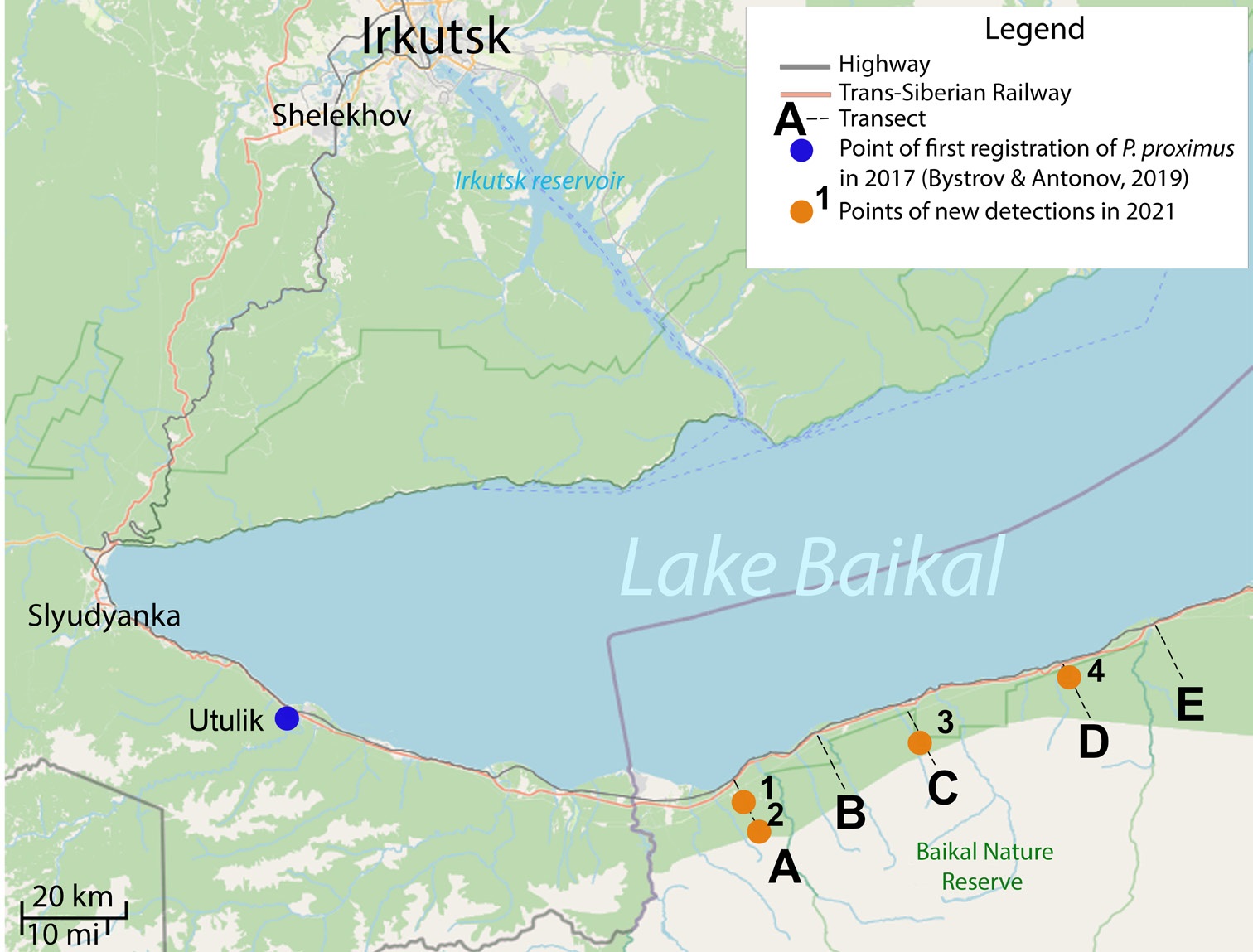Аннотация
The four-eyed fir bark beetle Polygraphus proximus Blandford, 1894 (Coleoptera; Curculionidae, Scolytinae) is an alien Far-Eastern stem pest rapidly spreading in the dark coniferous forests of Siberia. In 2021 we conducted a forest pathology research of Khamar-Daban fir forests in south coast of Baikal Lake. The main aim was to inspect the territory for populations of this species. We found three localities with P. proximus on two out of four transects and based upon photo materials represented by stuff of the Baikal Nature Reserve revealed another locality inhabited by the species. The characteristics of P. proximus populations such as occurrence, production, population density and the population growth rate in new localities were estimated. Since of our previous forest pathological inspection in 2014 it had spread eastward in Baikal region by at least 95 km. The highest site of P. proximus population was the slope of the valley of the Bolshoi Mamai River at an altitude of 1030 m above sea level. The estimated average speed of spread was about of 13-14 km per year. However, the most presumable invasion pathway of this species is the Trans-Siberian Railway. Thus, genetic analysis of sampled insects for the COI marker (mtDNA) revealed haplogroup I that previously was found as dominant variant in populations of Kemerovo and Tomsk Provinces. Despite the scattered distribution of P. proximus in Khamar-Daban fir forests the high population growth rate allows us to expect the formation of outbreaks during next decade.
Литература
Baranchikov YuN, Krivets SA (2010) About professional skills in determination of insects: how the occurrence of new aggressive invasive fir pest in Siberia was missed. In: Anyushin VV (Ed.) Ecology of Southern Siberia and Adjacent Territories 1 (14): 50–52. [In Russian]
Baranchikov YuN, Efremenko AA, Demidko DA, Titova VV (2020) Four-eyed fir bark beetle Polygraphus proximus Blandford (Coleoptera: Curculionidae, Scolytinae) in the western piedmont of the Ural Mountains: where, whence and when? In: Musolin DL, Kirichenko NI, Selikhovkin AV (Eds) XI Proceedings of the All-Russia conference with international participation. Saint Petersburg (Russia), November, 24–27. Saint Petersburg State Forest Technical University, St. Petersburg, 74–75 p. https://doi.org/10.21.266/SPBFTU.2020.KATAEV [In Russian]
Bykov R, Kerchev I, Demenkova M, Ryabinin A, Ilinsky Y (2020) Sex-specific Woldbachia infection patterns in populations of Polygraphus proximus Blandford (Coleoptera: Curculionidae: Scolytinae). Insects 11 (8): 547. https://doi.org/10.3390/insects11080547
Bystrov SO, Antonov IA (2019) First record of the four-eyed beetle Polygraphus proximus Blandford, 1894 (Coleoptera: Curculionidae, Scolytinae) from Irkutsk Province, Russia. Entomological Review 98 (1): 54–55. https://doi.org/10.1134/S001387381901007X
Bystrov SO, Morozova TI, Voronin VI, Oskolkov VA (2019) Invasion of the four-eyed fir bark beetle Polygraphus proximus Blandford in the dark coniferous taiga of Baikal region (Chamar-Daban Ridge). In: Forest Ecosystems of Boreal Zone: Biodiversity, Bioeconomy, Ecological Risks. Proceedings of the All-Russian Conference with International Participation. Krasnoyarsk (Russia), August 26–31, IF SB RAS, Krasnoyarsk, 70–72 p. [In Russian]
Dedyukhin SV, Titova VV (2021) Finding of the bark beetle Polygraphus proximus Blandford, 1894 (Coleoptera, Curculionidae: Scolytinae) in Udmurtia. Russian Journal of Biological Invasions 12: 258–263. https://doi.org/10.1134/S2075111721030048
Efremenko AA, Demidko DA, Baranchikov YuN (2019) Outbreak foci of the four-eyed fir bark beetle on the coast of Lake Baikal. In: Anyushin VV (Ed.) Ecology of Southern Siberia and adjacent territories: Proceedings of the XXIII International scientific school-conference of students and young scientists. Abakan, November 20–22. N. F. Katanov Khakas State University, Abakan, 41–42 p. [In Russian]
Folmer O, Black M, HoehW, Lutz R, Vrijenhoek R (1994) DNA primers for amplification of mitochondrial cytochrome c oxidase subunit I from diverse metazoan invertebrates. Molecular Marine Biology and Biotechnology 3: 294–299.
Forest pathology research (2014) Electronic page of the scientific department of the Baikal State Natural Biosphere Reserve (data of the last access 19.09.2022). https://baikalzapovednik.ru/science [In Russian]
Jones KL, Shegelski VA, Marculis NG, Wijerathna AN, Evenden ML (2019) Factors influencing dispersal by flight in bark beetles (Coleoptera: Curculionidae: Scolytinae): from genes to landscapes. Canadian Journal of Forest Research 49 (9): 1024–1041. https://doi.org/10.1139/cjfr-2018-0304
Kharuk VI, Im ST, Petrov IA, Yagunov MN (2016) Decline of dark coniferous stands in Baikal Region. Contemporary Problems of Ecology 9: 617–625. https://doi.org/10.1134/S1995425516050073
Kononov A, Ustyantsev K, Blinov A, Fet V, Baranchikov YuN (2016) Genetic diversity of aboriginal and invasive populations of four-eyed fir bark beetle Polygraphus proximus Blandford (Coleoptera, Curculionidae, Scolytinae). Agricultural and Forest Entomology 18 (3): 294–301. https://doi.org/10.1111/afe.12161
Krivets SA, Bisirova EM, Volkova ES, Debkov NM, Kerchev IA, Melnik MA, Nikiforov AN, Chernova NA (2018) Tekhnologiya monitoringa pihtovyh lesov v zone invazii ussurijskogo poligrafa v Sibiri. Metodicheskoe posobie. UMIUM, Tomsk, 74 pp. [In Russian]
Krivets SA, Kerchev IA, Bisirova EM, Demidko DA, Pet'ko VM, Baranchikov YuN (2015) Distribution of the four-eyed fir bark beetle Polygraphus proximus Blandf. (Coleoptera, Curculionidae: Scolytinae) in Siberia. Izvestia Sankt-Peterburgskoj Lesotehniceskoj Akademii 211: 33–45. [In Russian]
Rollins LA, Woolnough AP, Sinclair R, Mooney NJ, Sherwin WB (2011) Mitochondrial DNA offers unique insights into invasion history of the common starling. Molecular Ecology 20: 2307–2317. https://doi.org/10.1111/j.1365-294X.2011.05101.x
Tamura K, Stecher G, Peterson D, Filipski A, Kumar S (2013) MEGA6: Molecular evolutionary genetics analysis version 6.0. Molecular Biology and Evolution 30: 2725–2729. https://doi.org/10.1093/molbev/mst197
Авторы, публикующиеся в данном журнале, соглашаются со следующими условиями:
a. Авторы сохраняют за собой права на авторство своей работы и предоставляют журналу право первой публикации этой работы с правом после публикации распространять работу на условиях лицензии Creative Commons Attribution License, которая позволяет другим лицам свободно распространять опубликованную работу с обязательной ссылокой на авторов оригинальной работы и оригинальную публикацию в этом журнале.
b. Авторы сохраняют право заключать отдельные договора на неэксклюзивное распространение работы в том виде, в котором она была опубликована этим журналом (например, размещать работу в электронном архиве учреждения или публиковать в составе монографии), с условием сохраниения ссылки на оригинальную публикацию в этом журнале. с. Политика журнала разрешает и поощряет размещение авторами в сети Интернет (например в институтском хранилище или на персональном сайте) рукописи работы как до ее подачи в редакцию, так и во время ее редакционной обработки, так как это способствует продуктивной научной дискуссии и положительно сказывается на оперативности и динамике цитирования статьи


